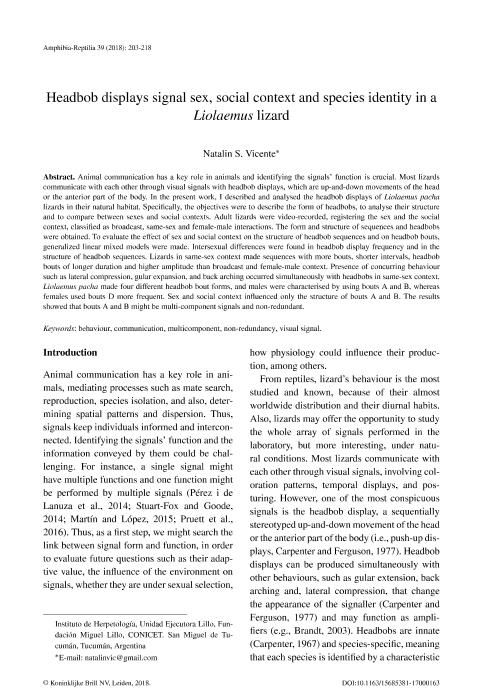Mostrar el registro sencillo del ítem
dc.contributor.author
Vicente, Natalin Soledad

dc.date.available
2019-10-17T20:21:45Z
dc.date.issued
2018-04
dc.identifier.citation
Vicente, Natalin Soledad; Headbobs displays signal sex, social context and species identity in a Liolaemus species; Brill Academic Publishers; Amphibia-Reptilia; 39; 2; 4-2018; 203-218
dc.identifier.issn
0173-5373
dc.identifier.uri
http://hdl.handle.net/11336/86190
dc.description.abstract
Animal communication has a key role in animals and identifying the signals’ function is crucial. Most lizards communicate with each other through visual signals with headbob displays, which are up-and-down movements of the head or the anterior part of the body. In the present work, I described and analysed the headbob displays of Liolaemus pacha lizards in their natural habitat. Specifically, the objectives were to describe the form of headbobs, to analyse their structure and to compare between sexes and social contexts. Adult lizards were video-recorded, registering the sex and the social context, classified as broadcast, same-sex and female-male interactions. The form and structure of sequences and headbobs were obtained. To evaluate the effect of sex and social context on the structure of headbob sequences and on headbob bouts, generalized linear mixed models were made. Intersexual differences were found in headbob display frequency and in the structure of headbob sequences. Lizards in same-sex context made sequences with more bouts, shorter intervals, headbob bouts of longer duration and higher amplitude than broadcast and female-male context. Presence of concurring behaviour such as lateral compression, gular expansion, and back arching occurred simultaneously with headbobs in same-sex context. Liolaemus pacha made four different headbob bout forms, and males were characterised by using bouts A and B, whereas females used bouts D more frequent. Sex and social context influenced only the structure of bouts A and B. The results showed that bouts A and B might be multi-component signals and non-redundant.
dc.format
application/pdf
dc.language.iso
eng
dc.publisher
Brill Academic Publishers

dc.rights
info:eu-repo/semantics/openAccess
dc.rights.uri
https://creativecommons.org/licenses/by-nc-sa/2.5/ar/
dc.subject
BEHAVIOUR
dc.subject
COMMUNICATION
dc.subject
MULTICOMPONENT
dc.subject
NON-REDUNDANCY
dc.subject
VISUAL SIGNAL
dc.subject.classification
Zoología, Ornitología, Entomología, Etología

dc.subject.classification
Ciencias Biológicas

dc.subject.classification
CIENCIAS NATURALES Y EXACTAS

dc.title
Headbobs displays signal sex, social context and species identity in a Liolaemus species
dc.type
info:eu-repo/semantics/article
dc.type
info:ar-repo/semantics/artículo
dc.type
info:eu-repo/semantics/publishedVersion
dc.date.updated
2019-10-16T19:13:30Z
dc.journal.volume
39
dc.journal.number
2
dc.journal.pagination
203-218
dc.journal.pais
Países Bajos

dc.journal.ciudad
Leiden
dc.description.fil
Fil: Vicente, Natalin Soledad. Consejo Nacional de Investigaciones Científicas y Técnicas. Centro Científico Tecnológico - Tucumán. Unidad Ejecutora Lillo; Argentina
dc.journal.title
Amphibia-Reptilia

dc.relation.alternativeid
info:eu-repo/semantics/altIdentifier/doi/https://dx.doi.org/10.1163/15685381-17000163
dc.relation.alternativeid
info:eu-repo/semantics/altIdentifier/url/https://brill.com/view/journals/amre/39/2/article-p203_6.xml
Archivos asociados
